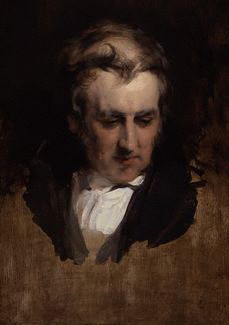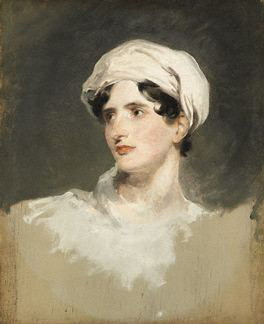Augustus Wall Callcott and Maria, Lady Callcott
“[Callcott] painted everything tolerably, and nothing excellently; he has given us no gift, struck for us no light, and though he has produced one or two valuable works…they will, I believe, in future have no place among those considered representative of the English School."
Ruskin’s withering assessment of the nineteenth-century landscape painter Augustus Wall Callcott was an inevitable consequence of his strong preference for Callcott's contemporary, J.M.W. Turner. Callcott died in 1844, and so was spared the humiliation of being described as an artistic non-entity by the man rapidly becoming the foremost art critic of the age. Furthermore, the last sentence of the above quotation was certainly prophetic, if not causal; despite enjoying a long and distinguished career in which he frequently garnered much greater accolades than Turner, Callcott has, with only three exceptions, merited only the briefest of references in surveys of nineteenth-century British art since his death. These generally follow the same pattern: following a brief biography, his major works are cited and the conclusion that he was a mere follower – even at times pasticheur – of Turner is inevitably drawn. Such a reductive analysis has severely diminished the importance of a man who was admired by both his artistic peers and the leading connoisseurs of the early nineteenth-century for his knowledge, judgement and taste, and who stood for President of the Royal Academy in 1830. Although he failed to garner the requisite number of votes for this particular position, his worth was recognised by Queen Victoria and Prince Albert when he was knighted in 1837 and subsequently given the coveted position of Keeper of the Royal Collection for the remainder of his life.

Augustus Wall Callcott was born on 20th February 1779 and, judging by his own recollections, found his childhood environment a formative influence regarding his future career: “in every room of the house were to be found prints after the best masters...tolerable oil copies from the Dutch and Flemish masters. There was also a considerable number of works by the best English authors.” Although surrounded by art, Callcott’s parents seem to have directed his youthful energies towards music, no doubt influenced by the accomplishments of his elder brother, the composer and organist John Wall Callcott. However, by 1797 he had enrolled as a student at the Royal Academy and was concurrently training in the studio of the portraitist John Hoppner. Callcott achieved early success with a sequence of pastoral landscapes (The Water Mill, 1805) and large marine pictures (Entrance to the Pool of London, 1816), and consistently attracted a high level of patronage. The rapid advancement of his career is reflected by his election as first an Associate of the Royal Academy in 1806 and then a full member in 1810.
In 1827, after almost fifty years as a bachelor, Callcott married. His new wife was the author and bluestocking Maria Graham, née Dundas (1785-1842). Maria’s literary career began shortly after her first marriage in 1810 to a naval officer, and was a product of the wide-spread travelling that such a union entailed (Journal of a Residence in India, Edinburgh, 1812). However, although her multiple forays into travel writing over the next decade or so garnered her critical attention, the breadth of her intellectual interests - fostered by her acquaintance and friendship with a variety of leading figures including Dugald Stewert, Ugo Foscolo, John Murray and Johann David Passavant - is reflected by the wider scope of her literary oeuvre, which comprised works on art history (Memoirs of the Life of Nicholas Poussin, London and Edinburgh, 1820), botany, religion (A Scriptural Herbal, London, 1842), European history and numerous translations of notable scholarly works. Maria Callcott, like her new husband, has suffered similar scholarly neglect despite her considerable reputation in the first half of the nineteenth century. There has, however, been a recent resurgence of interest in Maria as an early modern travel writer of considerable significance, but this does not reflect the scope of her achievements. Specifically, attention has not been directed to the final phase of her life comprising her marriage to Callcott, during which she arguably made her most valuable contributions to nineteenth-century British culture in the form of a series of publications which focused attention on early art.

Following their wedding on 20th February 1827, the Callcotts embarked on a year-long Grand Tour encompassing the Netherlands, Germany, Prague, Austria and Italy. This tour is extremely well documented by an abundance of archival material, some of which was unknown until recently. The multitude of journals, notebooks and sketchbooks filled by the Callcotts during their travels reveal a preoccupation with art of the medieval and early-Renaissance periods which, outside of a very exclusive circle of progressive artists and collectors, was in the early nineteenth-century considered unfashionable and unworthy of attention. In all the places they visited, the Callcotts paid exhaustive attention to the art of the ‘primitives’ (the nineteenth-century term applied pejoratively to artists working before the time of Raphael, in whom visual art was generally considered to have achieved perfection). Notably, also, their journals are replete with references to discussions about the historical progression of art with pioneering curators and collectors such as Carlo Lasinio in Pisa and the Boisserée brothers in Munich, and instances of viewing the works of and meeting contemporary revivalist painters, collectively known as the Nazarenes.
In 1835 the Callcotts privately published a monograph entitled Description of the Chapel of the Annunziata dell’Arena, or Giotto’s Chapel, in Padua, in which the text was written by Maria and the illustrations provided by Augustus. That this piece of scholarship has been almost entirely overlooked in fortuna criticas of Giotto and in the literature regarding the revival of interest in the primitives in general in England is hugely surprising. This was the first English monograph of the Arena Chapel, now considered one of the greatest monuments of early Italian art, but also on Giotto in general. Moreover, despite its being disseminated privately to a select audience, the volume appears to have percolated through British culture on a multiplicity of levels. Maria donated a copy of it to the Royal Academy library in 1835, meaning that all students and members of the institution had access to it as a visual resource. The strong similarity between one of Augustus’s illustrations and an image that appears in Anna Jameson’s Memoirs of Early Italian Painters (1845) further demonstrates that the Callcotts’ volume continued to be widely read. Finally, the brief report regarding the condition of the chapel and its artworks with which Maria begins her text is the obvious forerunner to the Arundel Society’s decision to commission and publish a series of wood-engravings recording the entirety of Giotto’s fresco cycle in the 1850s.
During their lifetimes, Augustus and Maria Callcott were very successful both critically and commercially. Moreover, they were recognised as a formidable partnership, counting leading artists, intellectuals and politicians amongst their friends and, c.1828-1842, presiding over arguably the most important artistic salon of the era. That their considerable achievements have been almost obscured by the activities of Charles and Elizabeth Eastlake, the much better known later power-couple of the Victorian art world, deserves redressing.
by Carly Collier, March 2012
Further Reading
D.B. Brown, Augustus Wall Callcott (1981)
D. B. Brown and C. Lloyd (eds.), The Journal of Maria, Lady Callcott, 1827-8 (1981)
R. B. Gotch, Maria, Lady Callcott: the creator of ‘Little Arthur (1937)
F. Haskell, Rediscoveries in Art: Some Aspects of Taste, Fashion and Collecting in England and France (1976)
